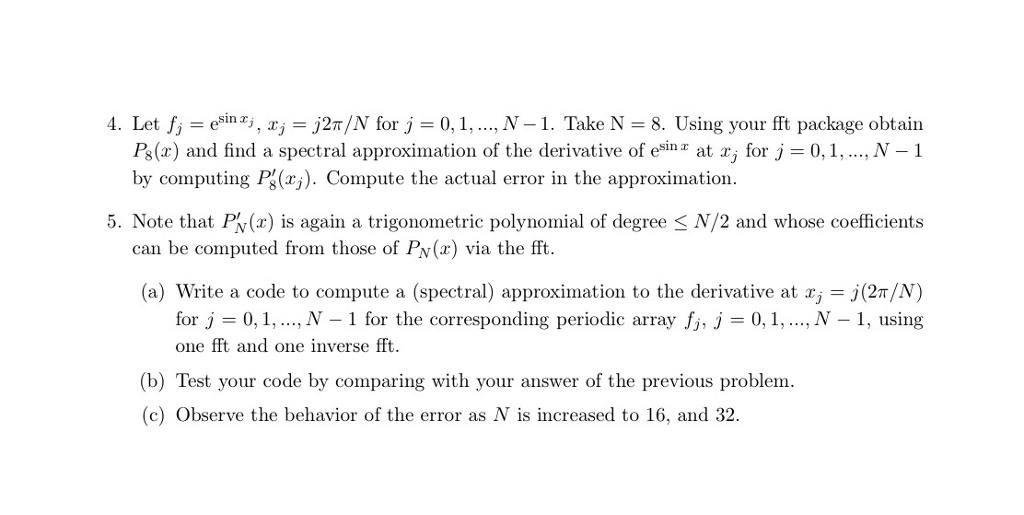Answered step by step
Verified Expert Solution
Question
1 Approved Answer
Please answer problem 5 The Discrete Fourier Transform (DFT) of a periodic array fi, for j 0,1 N-1 (correspond ing to data at equally spaced


Please answer problem 5
The Discrete Fourier Transform (DFT) of a periodic array fi, for j 0,1 N-1 (correspond ing to data at equally spaced points, starting at the left end point of the interval of periodicity) is evaluated via the Fast Fourier Transform (FFT) algorithm (N power of 2. Use an FFT package, i.e. an already coded FFT (the functions fft and ifft in Matlab or numpy.fft in python) 1. Let N-1 ck Prove that if the fi for j 0,1 N 1 are real numbers then co is real and cw-k ck where the bar denotes complex conjugate 2. Which fft package are you using? Read the manual of your fft package, and write down the formula it's using to return the coefficients. Note: different packages may use different definitions of the DFT, so it is very important to figure out what your package is calculating before using it 3. Let PN (r) be the trigonometric polynomial of lowest order that interpolates the periodic array f at the equidistributed nodes z j(2T/N), for j 0,1 N 1, i e. N/2-1 PN (r) ao ak cos kr bk sin ka) aN/2 cos (Tr for E 0,2T where N-1 for k N/2 fi cos kari, 0,1 ak N-1 fi sin kr for k 0, 1,..., N/2 1. Write a formula that relates the complex Fourier coefficients computed by your fft package to the real Fourier coefficients, ak and bk, that define PN(r) The Discrete Fourier Transform (DFT) of a periodic array fi, for j 0,1 N-1 (correspond ing to data at equally spaced points, starting at the left end point of the interval of periodicity) is evaluated via the Fast Fourier Transform (FFT) algorithm (N power of 2. Use an FFT package, i.e. an already coded FFT (the functions fft and ifft in Matlab or numpy.fft in python) 1. Let N-1 ck Prove that if the fi for j 0,1 N 1 are real numbers then co is real and cw-k ck where the bar denotes complex conjugate 2. Which fft package are you using? Read the manual of your fft package, and write down the formula it's using to return the coefficients. Note: different packages may use different definitions of the DFT, so it is very important to figure out what your package is calculating before using it 3. Let PN (r) be the trigonometric polynomial of lowest order that interpolates the periodic array f at the equidistributed nodes z j(2T/N), for j 0,1 N 1, i e. N/2-1 PN (r) ao ak cos kr bk sin ka) aN/2 cos (Tr for E 0,2T where N-1 for k N/2 fi cos kari, 0,1 ak N-1 fi sin kr for k 0, 1,..., N/2 1. Write a formula that relates the complex Fourier coefficients computed by your fft package to the real Fourier coefficients, ak and bk, that define PN(r)Step by Step Solution
There are 3 Steps involved in it
Step: 1

Get Instant Access to Expert-Tailored Solutions
See step-by-step solutions with expert insights and AI powered tools for academic success
Step: 2

Step: 3

Ace Your Homework with AI
Get the answers you need in no time with our AI-driven, step-by-step assistance
Get Started


